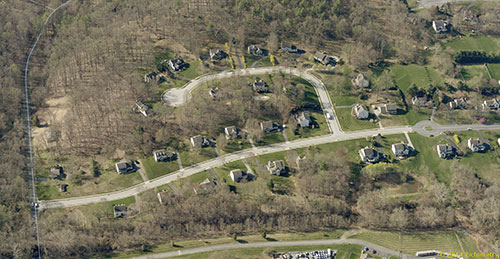Cul de sac & Spur Roads
Cul de sac
Cul de sac
(Y or T-shaped or circular turnarounds or dead-end streets)
A local road connected to the existing road network at only one end with a special provision for turning around at the closed end.
Standards
AASHTO: A 30-foot minimum radius. Use mountable curbs in residential areas if the cul-de-sac has less than a 47-foot radius with a central island. A 45-foot minimum radius should be used in commercial and industrial areas.
PennDOT: Recommended use of AASHTO standards. A cul-de-sac must have a 40-foot radius to qualify for Liquid Fuels Fund.
Comments
When properly designed, a cul-de-sac can be a useful technique for dealing with certain site configurations. When improperly designed, the cul-de-sac turnaround can create huge expanses of paved area requiring additional maintenance and generating excessive stormwater runoff. Cul-de-sac turnarounds should be required to include landscaped islands in the center to reduce impervious surface and provide a more attractive view both for homes facing the cul-de-sac and for residents of the subdivision in general.
The commonly used symmetrical design operates satisfactorily and is aesthetically pleasing, but better operation is obtained if the design is off-set so that the entrance-half of the pavement is in line with the approach-half of the street. One steering reversal is avoided in this design.

A landscaped cul-de-sac turnaround can significantly reduce impervious coverage and enhance a community's appearance.
The radius of a cul-de-sac should be no larger than necessary to permit free turning of the largest service vehicles regularly accessing the neighborhood. The minor inconvenience experienced by some drivers in reversing direction may not be an important consideration. If a school bus must access the cul-de-sac, larger radii should be provided. If a school bus does not have to access the cul-de-sac, smaller radii are acceptable as long as pedestrian access is provided. A smaller cul-de-sac radius minimizes impervious surfaces, decreases installation and maintenance costs, and decreases stormwater runoff. A right-of-way should be provided that is larger than the cartway radius.
A Y- or T-shaped turnaround for dead -end streets and short cul-de-sacs servicing up to 10 homes conserves land, reduces construction and maintenance costs, and permits flexibility in land planning and the siting of homes.
Using a central island minimizes impervious surfaces, provides visual relief from the pavement,provides a recharge basin for stormwater and can be used for storage of plowed snow in the winter. Mountable curbs bordering the island allow oversized vehicles to maneuver within the cul-de-sac.
Homes at the far end of a long cul-de-sac become more isolated and difficult to reach. Therefore, the anticipated traffic volumes and the number of housing units should be considered when determining cul-de-sac length. The minimum length of a cul-de-sac must be 250 feet to qualify for funding through the Liquid Fuels Tax Fund. In some cases there are access management benefits to allowing a cul-de-sac to be less than 250 feet.
Recommendations
The following recommendations apply to cul-de-sacs which are never intended to connect with adjoining, developable properties. If a cul-de-sac is intended to connect with future developments then it should be designed to accommodate its future function.
- Recommend use of an off-set cul-de-sac to create visual variety and improve the turning ease for drivers.
- The minimum radius of a residential cul-de-sac should be 40 feet with a 50-foot minimum right-of-way. If larger vehicles access the cul-de-sac, a radius greater than 40 feet may be needed. Excessive paving should be discouraged.
- Discourage the use of cul-de-sacs in commercial and industrial developments because they become idle space that may eventually be used as a storage area.
- Use central islands within a cul-de-sac. Provide a minimum radius of 45 feet for the cul-de-sac where parking demand is minimal. Where there is a demand for parking the minimum radius should be 52 feet with a 62-foot minimum right-of way. The central island should have mountable curbs for the occasional vehicle backup. The maintenance responsibilities of islands should be determined prior to construction.
- Generally, the minimum length of a cul-de-sac should be 250 feet. In some cases, a cul-de-sac less than 250 feet may be necessary for access management. Liquid Fuels Tax Fund regulations should be changed to allow this. The maximum length should be 1000 feet or a total of 25 single family or 50 multifamily residential units, whichever is more restrictive. This limits the number of vehicles using a single access point.
- A cul-de-sac turnaround should have a maximum grade of 4 percent. The grade of the cartway may be higher. The preferred drainage pattern is to allow stormwater runoff to go towards an intersection where the terrain permits. Central islands may be used as a place to store plowed snow.

Example of a cul-de-sac and a spur road in Caln Township.
Spur Roads
Spur Roads
(Stub street, access spur, partial street)
An improved, dedicated right-of-way adjacent to a tract for future access which can be utilized to create a local access network, including additional access for the original subdivision.
Spur roads provide for the future extension of roads into adjacent properties. They also provide better pedestrian circulation by linking neighborhoods, trails, bikeways or sidewalks and providing access from other subdivisions to commercial centers, schools or parks. Spur roads can reduce the impact of development on arterial roads by eliminating the need for new access points and by decreasing the amount of trips generated from subdivisions. Pedestrian safety is increased by separating users from unsafe roads with no shoulders or sidewalks and from high-speed arterials.
Recommendation
A spur road should be built to complement its intended function. If it eventually serves a distribution function, it should be designed accordingly. This precludes the need for the municipality to acquire additional right-of-way in the future. It also protects the existing structures and property values.



